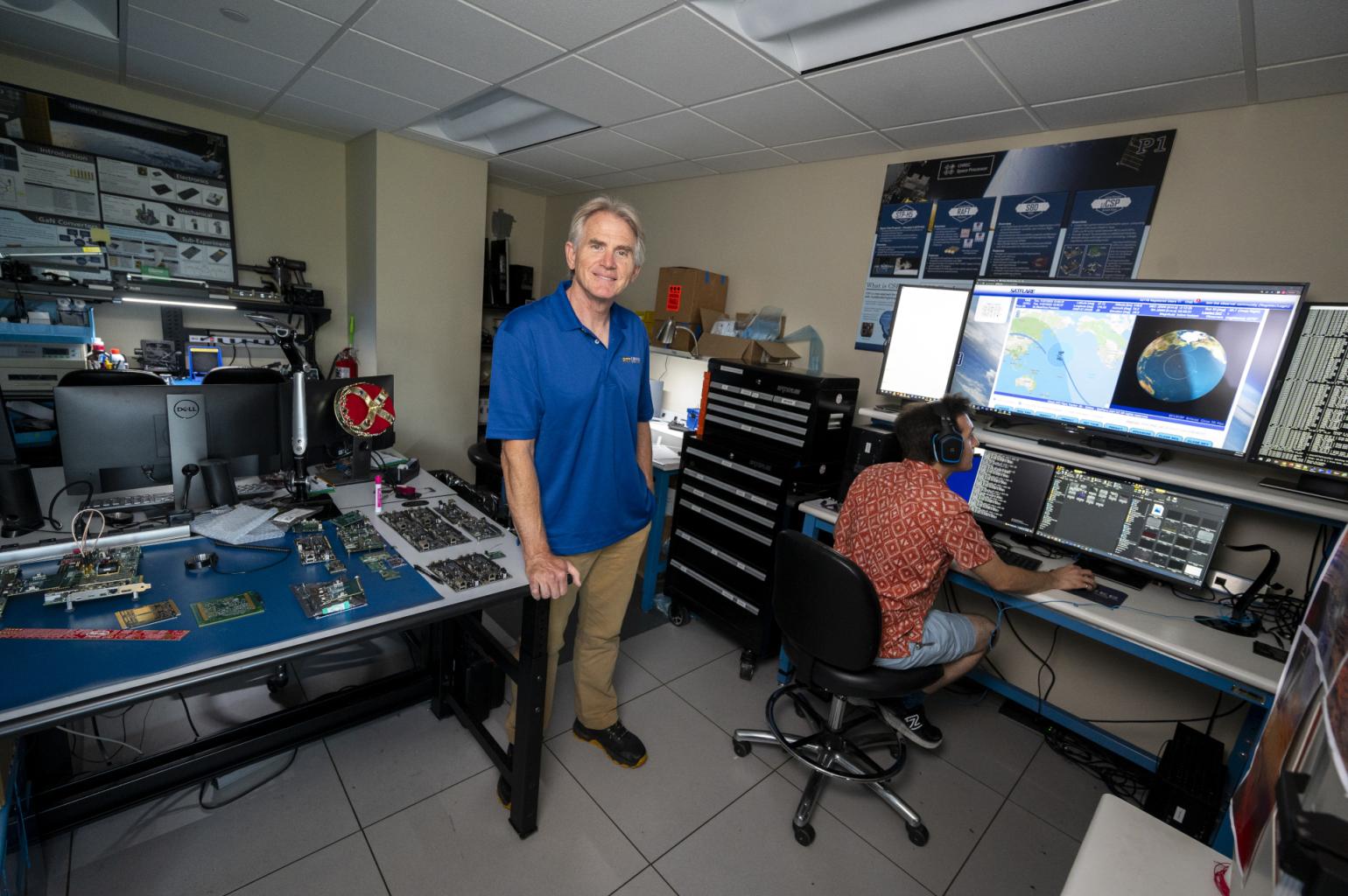
Alan George in the SHREC lab
Many fundamentals of modern life rely on space satellites – GPS, communications, weather forecasting, tracking climate and geological changes, scientific exploration, and defense systems. Each platform requires advanced computing onboard for remote sensing and data analysis, and that presents major challenges. Pitt students are working at the leading edge of this space research frontier.
Computing in space is not like computing on Earth, according to Alan George. He is the department chair and professor of electrical and computer engineering, and founder and director of the National Science Foundation Center for Space, High-performance, and Resilient Computing (SHREC), led by Pitt.
George explained that the challenge of computing in space has two sides: resource constraints and environmental hazards. Some examples of resources constraints are size, weight, power, cooling, and cost. Environmental hazards include severe shock and vibration on launch, wide temperature swings in Earth orbit, the airless vacuum of space where conventional cooling such as heat sinks and fans prove useless, and ionizing radiation emanating from our Sun and the cosmos.
“All these hazards wreak havoc on conventional electronic systems,” said George. “Due to these constraints and hazards, you can’t simply field data centers on spacecraft.”
Meanwhile, the need for advanced computing on spacecraft is escalating. “New missions are deploying increasingly sophisticated sensors that generate massive amounts of data. With limited communications bandwidth back to Earth, this data must be processed and managed by computers on the spacecraft. Most spacecraft are unmanned, so these computers must also make key decisions from data analysis.”
Hardware and software technology developed by students and faculty in SHREC has been used on many NASA and commercial space missions. SHREC students have even led several mission experiments on the International Space Station. With dozens of industry and government partners, SHREC operates like a space research consortium, where university research leads to breakthroughs shared with all partners.
George is particularly proud that SHREC is student centric. And the graduate students in the SHREC lab collaborate with the CRC for unique computing resources. For projects exploring communication patterns, graph analytics problems, Benchmarking systems path planning and machine learning, CRC offers hardware – and importantly, one-on-one support.
"We have an intimate relationship with CRC," says Jefferson Boothe, the team’s hyperscale computing lead, particularly calling out CRC’s co-director Kim Wong.
"One reason is that our research with CRC focuses on limitations of novel technology, which is where things begin to break," explains Calvin Gealy, the team’s scalable systems lead.
"Those applications cover graph processing, machine learning, bioinformatics, among many other domains, to stress different parts of these novel systems,” says Luke Kljucaricm the team’s reconfigurable systems lead. “Dr. Wong, Sasha Kessler, and everyone at the Network Operations Center have provided us with tremendous support, enabling us to focus on our research and shorten development time.”
The team is now working with Field-Programmable Gate Arrays (FPGA) programmable logic devices for applications where flexibility, speed, and parallel processing capabilities are required, like aerospace telecommunications.
George considers the students to be the heart of SHREC. “Work at SHREC is performed primarily by engineering graduate students. Alongside basic and applied research for new technology, the other key theme in SHREC is workforce development, where students are educated and trained to join and grow the US space community. We collaborate closely with our many partners and learn from each group’s different perspectives. It’s mutually beneficial and students see the benefits. They get real-world experience while earning their advanced degrees.”
George hopes that Pitt may grow to become a leading university contributor in the flourishing US space community. Several years ago, he conducted a campus survey and learned that more than 100 faculty members at Pitt are active or strongly interested in space research. He says, “Pitt has the talent and core competency to play a major role in terms of education, research, and service in space engineering, medicine, and science.”
- brian connelly
